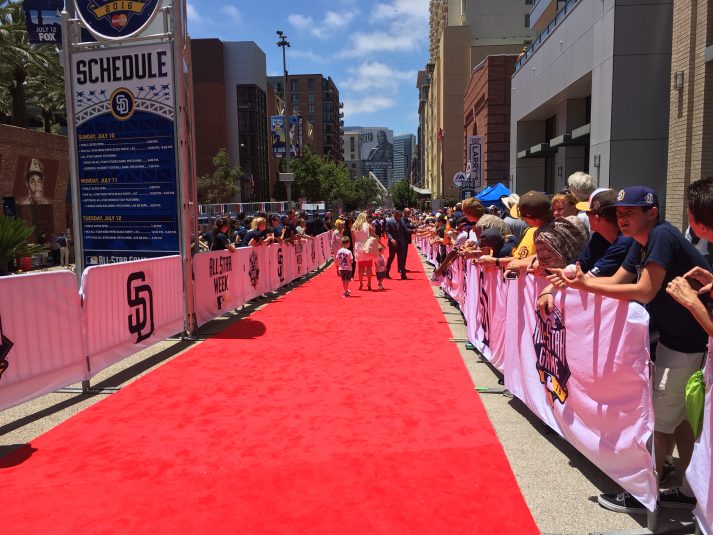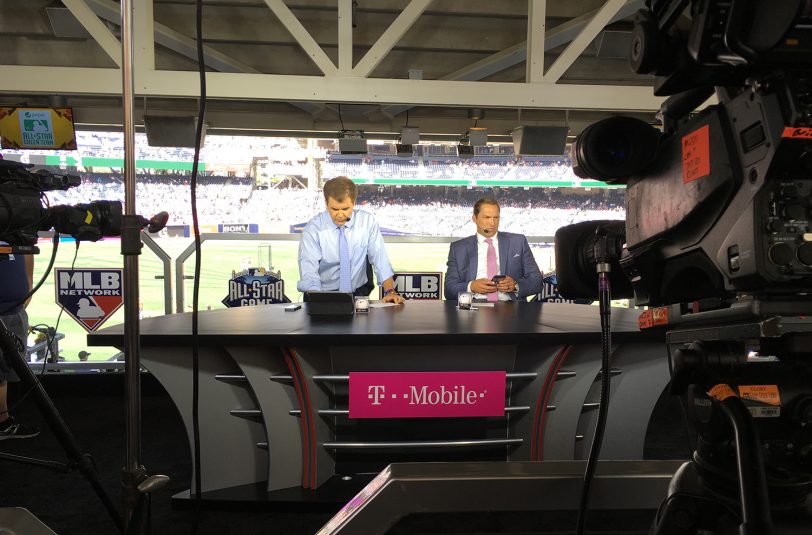Live From MLB All-Star: MLB Network Is All About ‘All-Access’ at Petco Park
Story Highlights
MLB Network is once again providing a wealth of behind-the-scenes access at this year’s MLB All-Star Week, delivering a more than 13 hours of live coverage, including player interviews, and sets on the field during Sunday’s All-Star Futures Game, Monday’s Home Run Derby, Tuesday’s All-Star Game, as well as press conferences and Fanfest. In addition, the Major League Baseball-owned network continues to cultivate the “One Baseball” philosophy in an effort to increase efficiency and synergy across all the MLB entities in San Diego, including MLBAM and the MLB world-feed production.
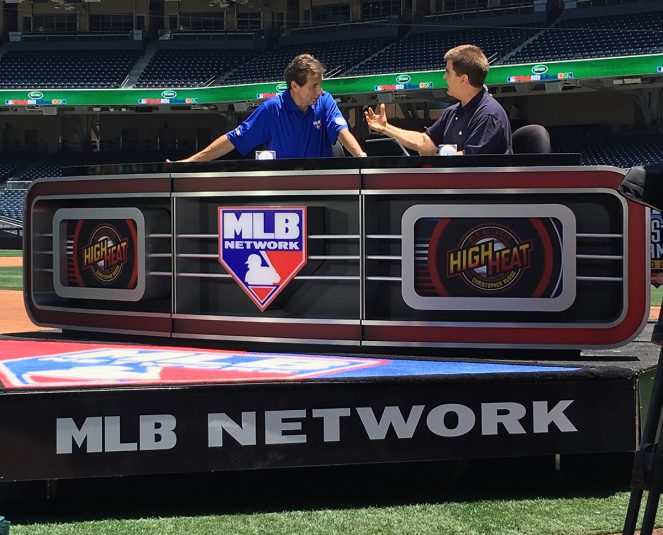
MLB Network primary set, which is wheeled on and off the field on a golf cart, is on the third-base line.
“We began this last year, and I felt that, here at All-Star, it’s truly one baseball,” says Susan Stone, SVP, operations and engineering, MLB Network. “In the past, there was a lot of duplication across different [MLB entities]. This way, we’re able to better service all the stakeholders, including partnering with MLB.com and what they’re doing on the digital end, delivering a better world feed than ever, and just providing greater access [to content] for everybody while also [creating] economies of scale.”
All-Access on the Field With Head-Mounted RF Cameras
High Heat, Intentional Talk, and MLB Tonight offered live on-field coverage leading up to the T-Mobile Home Run Derby on Monday, with analysts using wireless RF head-mounted cams to capture live HD footage of players during warm-ups and batting practice. The GlobeCam systems made by Telstra Broadcast Services and provided by CP Communications were worn by analyst Fred McGriff during the Futures Game on Sunday and Sean Casey during the Home Run Derby and All-Star Game. There are two systems: RefCam, which resembles a Bluetooth headset with a gyro-stabilized lens, and HatCam, which actually clips onto the brim of a hat.
“What we found at Futures was that we like the RefCam a little better but it doesn’t work well with a batting helmet,” says Jason Hedgcock, manager, remote technical operations, MLB Network. “So we used the HatCam at Futures, and Sean Casey will be wearing the gyro-stabilized one the rest of the way.”
Besides these RF cameras, MLB Network has a pair of handhelds roaming the field and four hard cameras higher up during batting practice.
Plenty of player access will be on display during Tuesday’s Red Carpet Show, for which MLB Network is rolling out a standalone production as the All-Star parade concludes at Petco Park.
“We don’t have a physical set now at Red Carpet,” says VP, Remote Operations, Tom Guidice. “It’s more casual. We tested that out last year, and everybody seemed to like it. We’ll have a jib and two cameras there, and we’ll have plenty of coverage. But we just didn’t want to have it be a sit-down; we wanted to have it be more a stand-up, more the feel of the red carpet.”
Plenty of Sets and a New Fiber Rack
MLB Network has rolled out a pair of three-camera sets at Petco Park: its primary set on the third-base line and a secondary set in the concourse. With limited space in the camera well on the field level, the network did not have enough space on the field for all its racks for its on-field set. The network worked with CP Communications developing a portable fiber rack for its three-camera set that has dramatically changed the operation.
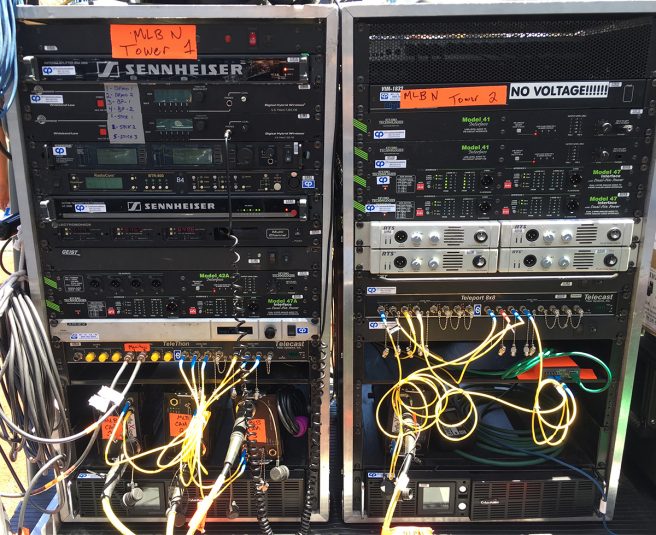
MLB Network worked with CP Communications to develop a portable fiber rack for its three-camera on-field set.
“Previously, we had been [transmitting] all our field sets over fiber and using around 20 strands of fiber,” says Hedgcock. “Now we’ve gotten some Multidyne fiber boxing products to get us down to just four strands for all of our cameras and audio. And we’re actually using a SMPTE fiber so that we can just run two SMPTE [fibers] instead of needing tactical and all that single-strand fiber everywhere. We plug in two SMPTE fibers, and our racks are ready to go. We were actually thinking about this for years, and this kind of forced us to do it.
The cart is wheeled onto the field with a golf cart when the set is set up and then quickly wheeled off at strike.
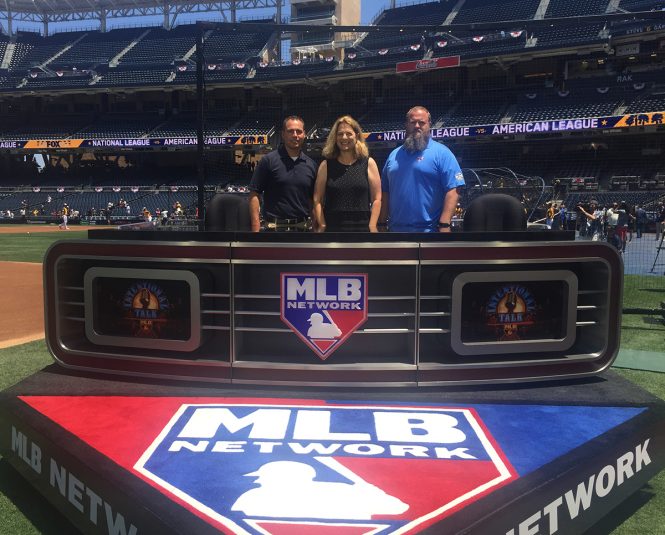
MLB Network’s (from left) Tom Guidice, Susan Stone, and Jason Hedgcock at the primary on-field set
“The other, unintended bonus is that, typically, we’d have to have everything down on the field in order to do any sort of check,” Hedgcock adds. “So we were always delayed by rehearsals and what not. Now we can hook the cart up out at the truck, make sure all the equipment’s working the way we want it to. Then, when we bring it out to the field, as long as the fiber link is good, we know we are good to go. It gives us a little more time to tweak things and be a little more prepared for when we actually get the access to the field.”
The set itself was designed and constructed by Filmwerks and resides on a motorized cart to allow a quick strike 30 minutes before first pitch of the Derby and All-Star Game. With the portable fiber rack and motorized set, MLB Network is capable of getting the entire set off the field in just five minutes.
“We’re looking forward to having two of these [fiber systems] for the World Series, and I think, regardless of space issues, this is going to be our workflow going forward,” says Guidice. “This eliminates any potential issues, so we control everything now better. Jason [Hedgcock] and CP did an excellent job putting it all together.”
‘One Baseball’ in Full Effect
MLB Network has rolled out Game Creek Video Glory A and B for its studio ops, Maverick for the Futures Game, All-Star world feed, Edit 2 for its onsite edit operations, and Justice for the Red Carpet show. All operations are more cohesive than ever, thanks to an integrated EVS network and file-transfer system across all shows.
“We are servicing the world feed and studio coverage out of essentially one of our units, and we integrated the EVS networks this year and are using a file-transfer system from our network,” says Hedgcock. “This way, we can feed everything to the EVS as one group, so we’re not feeding scenics to the world feed and scenics to the studio; we have a spot in the EVS where all the scenics drop. So we’re using the resources better, and it allows us to use fewer EVSs and have more access.”
Stone says this effort will be standard at large MLB shows moving forward — especially the World Baseball Classic next spring.
MLB Network is also testing a large NAS drive that would grant the onsite operation access to all content at MLB Network headquarters in Secaucus, NJ.
“If they want to put together that tease that shows here’s the other games that have occurred, we’re not trying to build that feed. They can just grab the files and push over the data. It’s a lot of testing for that, but it has been really positive so far. This is the next step in unifying all this, and [we’re] starting to look at how we can manage our technical resources better to service everybody at once, as opposed to each individual entity.”
The same production and ops crews handled the Futures Game and world-feed productions this year, creating stronger continuity from show to show. The MLB Network/MLB international world feed also deploys seven dedicated cameras while sharing several camera feeds with Fox.
